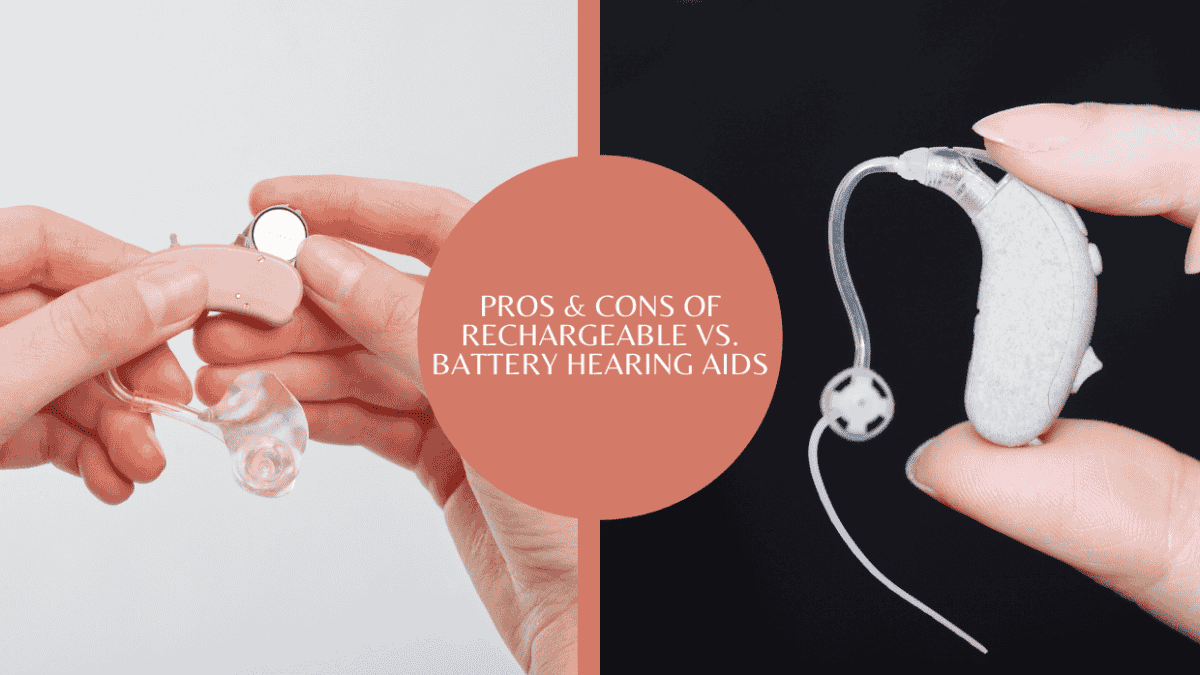Although rechargeable hearing aids have been around for over 30 years, they have only had limited success. This can be attributed to difficult-to-operate charging stations. Previous incarnations of the rechargeable hearing aid had other drawbacks, such as perceived low reliability, size, and circuit constraints. In light of these possible drawbacks, most users have opted for hearing aid technology that is always changing, with new devices, enhancements, and updates being released every year. It all started with rechargeable batteries in hearing aid devices, and now rechargeable hearing aids are the latest breakthrough. On the other hand, cutting-edge technology has dramatically transformed the industry and how people with hearing loss interact with the world. Continue reading to learn more about the growth of rechargeable hearing aids and their batteries and their advantages.
What is a rechargeable hearing aid?
Compared to hearing aids with standard disposable batteries, rechargeable hearing aids have built-in batteries that do not need to be removed regularly. Rather than removing the batteries, you can charge your hearing aids at night with a charging mechanism, similar to how smartphones are recharged.
Rechargeable hearing aid and batteries have a lot of advantages.
Digital hearing aids today are jam-packed with more technology and functions than ever before, including smartphone compatibility. However, these increased features will quickly deplete battery life, forcing users to replace batteries frequently. Hearing aid batteries must be user-friendly, strong, and convenient to provide the best experience for hearing aid users with hearing loss. These cutting-edge features are powered by advanced batteries that offer a slew of surprising benefits.
- Superior comfort & ease of use
Hearing aids now have various technological advancements that eliminate the need to replace small batteries. Instead, place the device on the charger while sleeping. When you wake up in the morning, you will find a fully charged and rejuvenated aid ready to use. This feature is especially beneficial for people with age-related health conditions like Parkinson’s disease, dementia, dexterity challenges, and arthritis.
- Mindfulness
The prospect of a dead battery can be a stressful and humiliating experience. The dread that the battery would fail at the worst possible time is real for many hearing aid users. When you charge your battery overnight, though, you would not have to worry about your smartphone dying in the middle of the day. The best part is that users of rechargeable hearing aids will never have to worry about replacing the battery.
- Long-term storage
Almost every rechargeable hearing aid battery on the market today is protected by a high-quality, durable shield. This extra safeguard prevents the battery from draining or drying up prematurely. This was a common issue with previous zinc-air battery generations. According to various tests, rechargeable batteries also have a considerably stronger capacity to survive adverse weather and extreme conditions.
- Flexibility is abundant.
For other people, the sole commitment to utilising rechargeable batteries is too restrictive. Many hearing aids are available with both rechargeable and zinc-air batteries if you fall into this category. This increased adaptability provides critical backup power if you neglect to charge the battery.
- Environmentally friendly and green
Rechargeable hearing aid batteries are far more environmentally beneficial than disposable hearing aid batteries for green, environmentally friendly options. When you dispose of a battery, acid and lead are released into water supplies and the environment, which can be dangerous. Two digital hearing aids can necessitate the disposal of over 300 hearing aid batteries over three years. Two rechargeable hearing aids, on the other hand, will only use six rechargeable batteries over the same period.
- It is better for the elderly.
Hearing aid users who are older or have restricted mobility may find it challenging to purchase and replace batteries. They may be unable to purchase batteries when required, and those with low motor abilities may have difficulties opening the door to access the batteries.
Reason to prefer rechargeable and battery operated hearing aids
The batteries have substantially improved as manufacturers continue to make technological breakthroughs. These batteries have improved to the point where they are as powerful and long-lasting as those found in cell phones and computers. Many people feel that they provide a more convenient way to engage in conversation while also hearing when and when they need to. Here is the reason to prefer rechargeable hearing aids.
- User-friendliness
Disposable batteries are quite small. The package may be difficult to understand. It could be a deal-breaker if you have poor dexterity due to injury or ageing. When using rechargeables, all you have to do is plug them in before going to bed. You will have all-day power when you wake up.
- Children and pets will be safer.
Disposable batteries are the ideal size and form for small hands and mouths. They are, however, exceedingly hazardous if consumed. Rechargeable hearing aids are significantly less likely to be swallowed if they are kept in your ears or the charger at all times.
- Streaming is more enjoyable.
The use of Bluetooth and streaming music depletes the batteries in your hearing aids more quickly. Rechargeable is a better choice if you expect to use either of them frequently. You can recharge your hearing aids instead of using disposables to save money.
Rechargeable hearing aids are increasing in popularity.
Rechargeable hearing aids will become even more prevalent as sound quality, battery efficiency and interchangeability, and cosmetic appeal, improves. Recharge ability emerged to attract individuals into the hearing aid sector over the last 35 years. Every seven years or so, it resurfaces as something fresh and new, and then it vanishes. This final wave has established itself as a mainstay. The current generation of technology has come close to matching customer demands, which is why people believe it will become more commonplace in the future. Patients who use rechargeable hearing aids enjoy them and are at ease with them. People got those for a reason as they were suitable for them and matched their requirements.
How much do rechargeable hearing aids cost?
Rechargeable hearing aids, like most medical devices, are an investment. The cost of rechargeable hearing aids varies and is determined by the style, high-tech features, servicing and maintenance, and your unique healthcare plan. Rechargeable hearing aids may have lower performance levels and fewer advanced features as their price drops. Less priced rechargeable digital hearing aids are less likely to include smart capabilities like Bluetooth connectivity. This permits you to stream audio directly to your hearing aids from a variety of sources. A hearing care specialist can help you choose the finest rechargeable hearing aid for you and explain the cost of the device and the professional services that come with it.
What is the battery life of rechargeable and battery operated hearing aids?
The device determines the battery life of hearing aids. The batteries may be fully charged in three hours and have a battery life of up to 30 hours. You may get 24 hours of battery life even if you only watch TV or listen to music 50% of the time. Quick charge offers 3 hours of battery life in just 10 minutes if you are in a hurry.
How to care for rechargeable and battery operated hearing aid batteries?
- Rechargeable hearing aid batteries should be removed and placed on a soft cloth if they have a battery door. This will allow you to thoroughly clean the battery compartment without causing damage to the battery on the side.
- When the hearing aids are kept ideal, place them in the charging station if the batteries do not need to be removed. You do not have to wait until the batteries are completely depleted before charging them, and you may do so while showering.
- Never leave any rechargeable hearing aids in an unplugged charging station. If you do this, the battery life will be reduced, and the remaining life will be depleted.
- If you cannot use your hearing aid charging station, opt to turn off your hearing aids and store them safely while not in use.
- Place lithium-ion hearing aids in the charging station only when they are fully dry and free of debris.
The indicator light will turn on when you set the hearing aids in the charging station, and you will be able to view your hearing aids charging. It will take four hours for them to charge, after which you can use them again fully.
Wrapping it up
You would not have to bother about replacing the batteries with rechargeable hearing aids. They are made to last the entire lifetime of a hearing aid. With each recharge, the charge is reduced to a half-life. The power of a fully charged hearing aid remains constant with rechargeable hearing aids. This gives hearing aid users active lifestyles that may be away from a charging source for long periods of peace of mind. Furthermore, the use of rechargeable hearing aids does not necessitate a high level of skill. They are simple to use. Thus, if you need a hearing aid, seek rechargeable and battery operated hearing aids and contact your local hearing centre to find out which type is right for you.





